The Vishera Review: AMD FX-8350, FX-8320, FX-6300 and FX-4300 Tested
by Anand Lal Shimpi on October 23, 2012 12:00 AM ESTProjected Performance: Can AMD Catch up with Intel?
I keep going back to this slide because it's incredibly relevant. It's the only indication we have from AMD of what its future roadmap will look like in terms of performance increases:
Each year AMD promised to increase performance of its high-end cores by roughly 10 - 15%. Astute observers will note that, at this rate, AMD will almost never catch up to Intel. AMD at the time was careful to point out that it's talking about 10 - 15% gains in core performance, and it could potentially see even larger increases in total chip performance by pulling other levers. Vishera is an example of AMD doing just that. The Piledriver cores by themselves don't increase performance tremendously, but they do give AMD a little more thermal headroom to work with thanks to some more efficient design decisions and better transistor choice. With Vishera, AMD took the additional power headroom and turned into a frequency advantage. The result is AMD's FX-8350 can operate in the same power envelope as the outgoing FX-8150, yet runs at an 11% higher base clock (turbo frequency remains the same). Through frequency and core level improvements, AMD was able to deliver a bit more than the 10 - 15% performance increased in promised.
If AMD is able to repeat these improvements again next year, I wondered whether or not it would get any closer to closing the gap with Intel - particularly when it came to single threaded performance. We already know from our Haswell investigations that Intel is expecting around a 5 - 15% increase in CPU performance from Haswell over Ivy Bridge. If we assume that Haswell delivers towards the 15% end of that spectrum, and if we assume that Steamroller delivers the same level of improvements that we saw from Piledriver/Vishera, we end up with some pretty interesting predictions for where things end up next year. I modeled the 2013 performance of high-end AMD and Intel platforms based on those two factors and plotted the curves in a few different benchmarks. For each generation I used the parts that AMD stacked up against one another (they are also fairly similarly priced). For 2011 I used the FX-8150 vs. Intel's Core i5 2500 and for 2012 I used the FX-8350 vs. Intel's Core i5 3570. The 2013 data is of course projected based on a 15% increase in performance from Haswell, and a repeat of the Vishera vs. Zambezi increase for AMD. This is mostly an interesting experiment so don't get too invested in the data.
We'll start with Cinebench, by far the most painful of the tests for AMD from a single-threaded performance perspective:
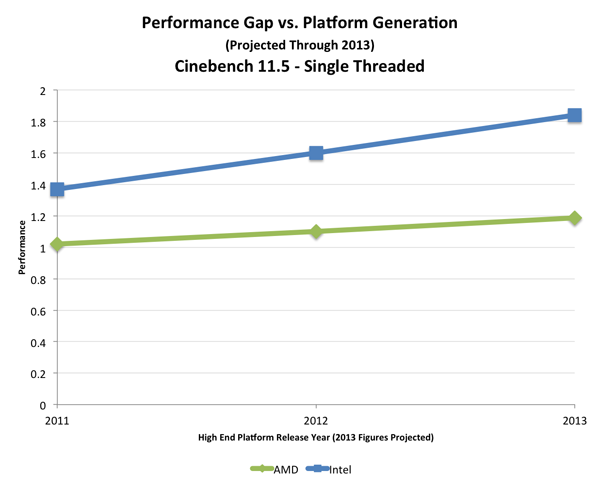
The Vishera gains here were decent but not enough to dramatically shrink the performance gap. Furthermore, Intel put a good amount of distance in place with Ivy Bridge and if it can continue that with Haswell I don't see much hope here.
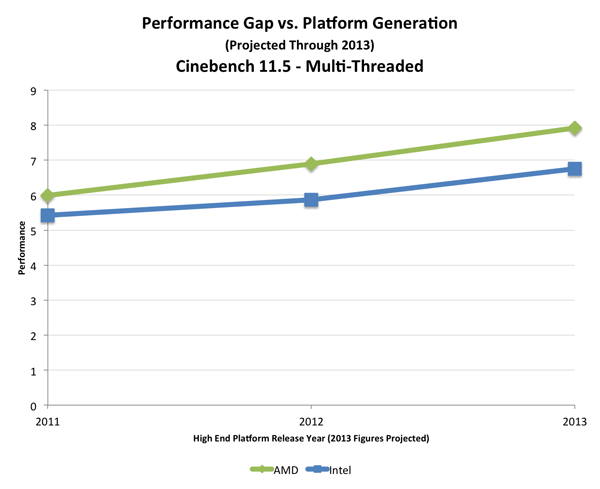
The multithreaded Cinebench results begin in AMD's favor and remain so even with our projected performance data.
Mozilla's Kraken benchmark is another example of single threaded performance gone awry for AMD.
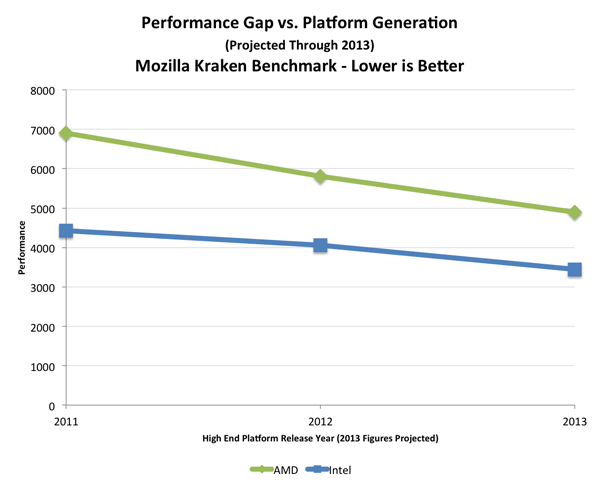
Thankfully, Vishera does close the gap by a decent amount and if AMD extends those gains it is on an intercept course with Intel. The bad news is, that intercept wouldn't be in 2013.
POV-Ray provides another point of view on single threaded performance, here the situation looks far less dire than under Cinebench:
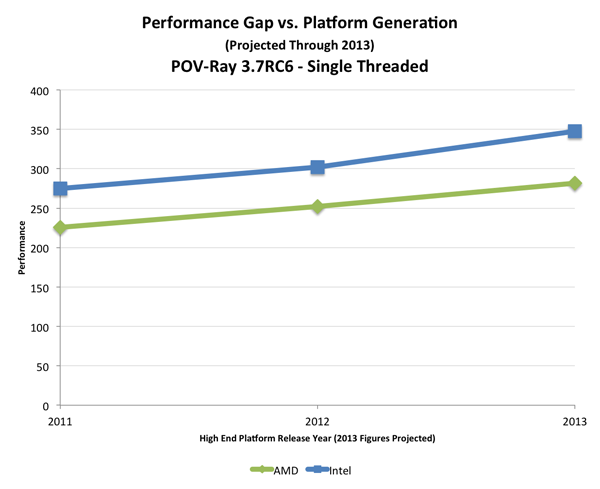
Unfortunately the curves remain fairly distinct.
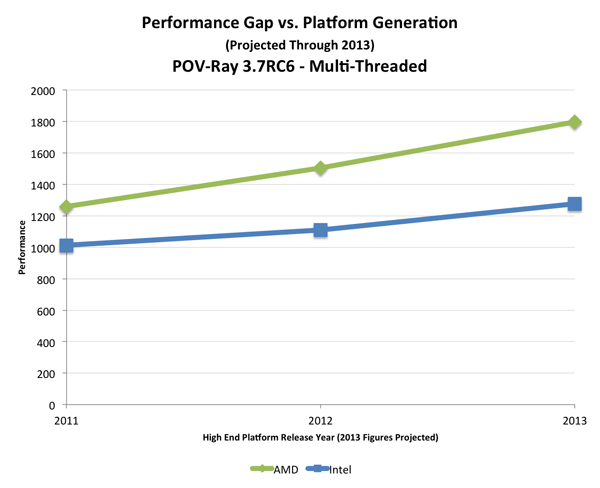
Once again, when we increase thread count we see AMD pull ahead.
SYSMark is a particularly telling benchmark as it is lightly threaded and does a good job of simulating all types of workloads:
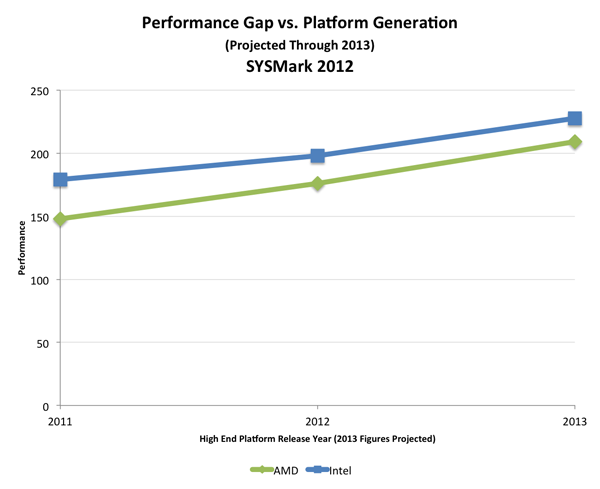
The result here is AMD closing in, albeit slowly, on Intel's performance advantage. I suspect this is quite possibly the best case scenario for AMD, it doesn't necessarily want to surpass Intel in performance but it wants to get close enough where pricing and other factors (e.g. GPU performance in its APU parts) can make a bigger difference.
Our Visual Studio 2012 test is a good combination of single threaded and multithreaded workloads in one:
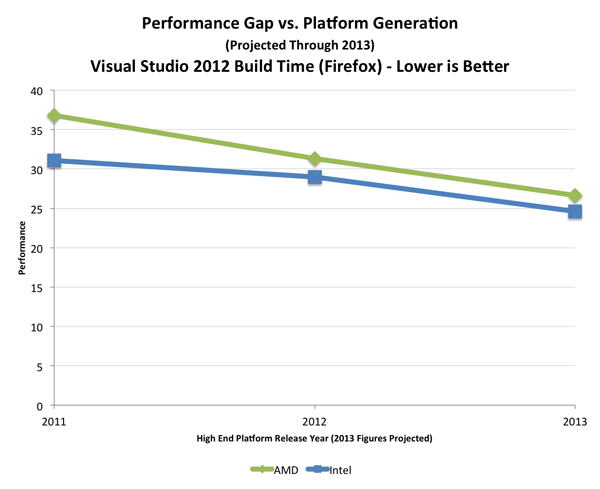
With Vishera, AMD did a lot to close the gap betwen itself and Intel. Another increase like this and we won't see AMD surpass Intel, but the two should remain fairly close.
These last two tests show us the other side of the coin. If both AMD and Intel continue on their present tracks, what will happen in a test where AMD already does well today?
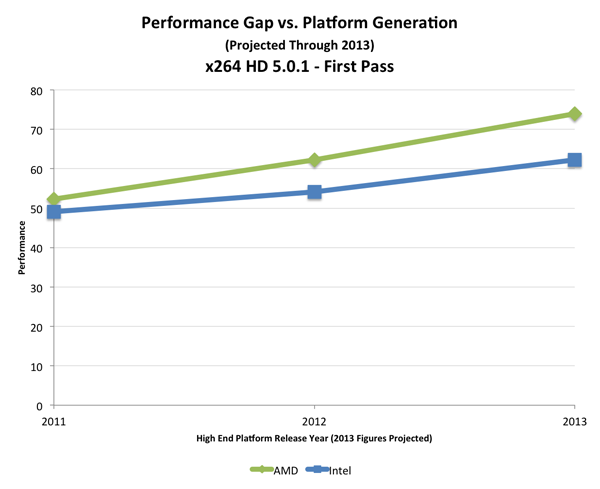
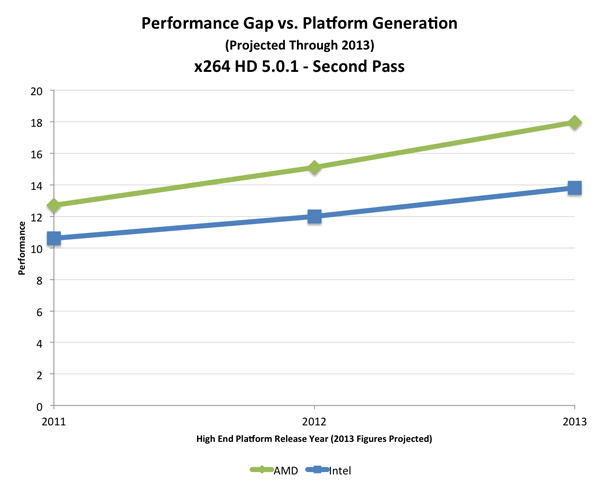
In areas where AMD holds a significant advantage, Haswell would need to deliver more than a 15% gain in performance at the same price point to catch up.
None of the results here are all that surprising. AMD remaining on its current course isn't enough to dramatically change its standings vs. Intel in another year. Vishera definitely cut into the performance delta, but the 2013 follow-up will have to do even more to really have an impact. Steamroller is far more focused on increasing IPC, however without a new process node it'll be difficult to demonstrate another gain in frequency like we see today with Vishera. I suspect the real chance for AMD to approach parity in many of these workloads will be with its 20nm architecture, perhaps based on Excavator in 2014.











250 Comments
View All Comments
CeriseCogburn - Tuesday, October 30, 2012 - link
more speculation from mr gnuThis of course caps it all off - the utter amd fanboy blazing in our faces, once again the FANTASY FUTURE is the big amd win :
" If they make a server chip based on that technology, with high performance-per-watt and 12 or more cores, that is very well within realms of possible and could very well be a GREAT winner in that market. "
LOL - Why perhaps you should be consulting or their next COO or CEO ?
I'm telling you man, that is why, that is why.
Siana - Thursday, October 25, 2012 - link
It looks like extra 10W in idle test could be largely or solely due to mainboard. There is no clear evidence to what extent and whether at all the new AMD draws more power than Intel at idle.A high end CPU and low utilization (mostly idle time) is in fact a very useful and common case. For example, as a software developer, i spend most time reading and writing code (idle), or testing the software (utilization: 15-30% CPU, effectively two cores tops). However, in between, software needs to be compiled, and this is unproductive time which i'd like to keep as short as possible, so i am inclined to chose a high-end CPU. For GCC compiler on Linux, new AMD platform beats any i5 and a Sandy Bridge i7, but is a bit behind Ivy Bridge i7.
Same with say a person who does video editing, they will have a lot of low-utilization time too just because there's no batch job their system could perform most of the time. The CPU isn't gonna be the limiting factor while editing, but when doing a batch job, it's usually h264 export, they may also have an advantage from AMD.
In fact every task i can think of, 3D production, image editing, sound and music production, etc, i just cannot think of a task which has average CPU utilization of more than 50%, so i think your figure of 80Wh/day disadvantage for AMD is pretty much unobtainable.
And oh, noone in their right mind runs an internet-facing server as their desktop computer, for a variety of good reasons, so while Linux is easy to use as a server even at home, it ends up a limited-scope, local server, and again, the utilization will be very low. However, you are much less likely to be bothered by the services you're providing due to the sheer number of integer cores. In case you're wondering, in order to saturate a well-managed server running Linux based on up to date desktop components, no connection you can get at home will be sufficient, so it makes sense to co-locate your server at a datacenter or rent theirs. Datacenters go to great lengths to not be connected to a single point, which in your case is your ISP, but to have low-latency connections to many Internet nodes, in order to enable the servers to be used efficiently.
As for people who don't need a high end system, AMD offers better on-die graphics accelerator and at the lower end, the power consumption difference isn't gonna be big in absolute terms.
And oh, "downloading files" doesn't count as "complex stuff", it's a very low CPU utilization task, though i don't think this changes much apropos the argument.
And i don't follow that you need a 125$ mainboard for AMD, 60$ boards work quite well, you generally get away with cheaper boards for AMD than for Intel obviously even when taking into account somewhat higher power-handling capacity of the board needed.
The power/thermal advantage of Intel of course extends to cooling noise, and it makes sense to pay extra to keep the computer noise down. However, the CPU is just so rarely the culprit any longer, with GPU of a high-end computer being the noise-maker number one, vibrations induced by harddisk number two, and only to small extent the CPU and its thermal contribution.
Hardly anything of the above makes Piledriver the absolute first-choice CPU, however it's not a bad choice still.
Finally, the desktop market isn't so important, the margins are terrible. The most important bit for now for AMD is the server market. Obviously the big disadvantage vs. Intel with power consumption is there, and is generally important in server market, however with virtualization, AMD can avoid sharp performance drop-off and allow to deploy up to about 1/3rd more VMs per CPU package because of higher number of integer cores, which can offset higher power consumption per package per unit of performance. I think they're onto something there, they have a technology they use on mobile chips now which allows them to sacrifice top frequency but reduce surface area and power consumption. If they make a server chip based on that technology, with high performance-per-watt and 12 or more cores, that is very well within realms of possible and could very well be a GREAT winner in that market.
Kjella - Tuesday, October 23, 2012 - link
Except the "Any CPU is fine" market isn't about $200 processors, Intel or AMD. That market is now south of $50 and making them pennies with Celerons and Atoms competing with AMD A4 series. You're not spending this kind of money on a CPU unless performance matters. Funny that you're dissing the overclockability of the IVB while pushing a processor that burns 200W when overclocked, you honestly want THAT in your rig instead.Honestly, while this at least puts them back in the ring it can't be that great for AMDs finances. They still have the same die size and get to raise prices of their top level process or from $183 to $199, yay. But I guess they have to do something to try bringing non-APU sales back up, Bulldozer can not have sold well at all. And I still fear Haswell will knock AMD out of the ring again...
Jaybus - Tuesday, October 23, 2012 - link
I agree. I would think they may do better with the 16-core socket G34 Opterons with 4 RAM channels, particularly if they can get down to 95W at 2.5 GHz. A 2-socket board gives 32 cores with lots of RAM per 2U server chassis. This should work nicely for high availability virtualized clusters. In this environment, it is better to have more cores in the same power envelope than faster per-core performance, because the virtual machines are independent from one another. I think Piledriver can compete in this environment much better than in the non-APU desktop/workstation market.Sufo - Tuesday, October 23, 2012 - link
"If all you do is benchmark all day long and you have money to burn, blow it on an Intel CPU"Uh, I'd happily take one to play games on my "Windoze" machine.
Idiot.
cfaalm - Tuesday, October 23, 2012 - link
The thing is that people would want a balanced performance. Balanced between single and multithreaded that is. Now Piledriver does a lot better than Bulldozer here, but I think Intel offers a better balance still. As much as I would like to build a new AMD system, I think it will be Intel this time around.lmcd - Tuesday, October 23, 2012 - link
What class of gaming are you looking at? If you're looking at even midrange gaming, your best bet is an A10 + a 6670 (runs $60-$70 average and $90 for low profile). Really a great gaming value option.just4U - Tuesday, October 23, 2012 - link
lmcd,I just did that for our secondary machine and put in a 6850. Works quite well... aside from bios issues on a brand new board chipset that is. Considering prices on the 7750/70 I'd probably opt out for one of those at $30 more then any of the 6x series. I'd also have probably picked up one of these new cpu's over a A10 given the oportunity.
CeriseCogburn - Tuesday, October 30, 2012 - link
LMAO at fanboy system frikk failure.... hahahahha "adise from bios issues" and uhh.. the "crashing" .. and uhh, I'd buy not the 6850, but 7770, and uh... not the A10 but one of these...LOL - there is the life of the amd fanboy
'nar - Tuesday, October 23, 2012 - link
I frequently have two or three high-cpu apps running at a time, so would AMD be better in this case? Even though each app runs better on Core-i5 individually?I shoot for a do-it-all system. I run video encode, get bored and start a game. I run malware scans on external drives and backup other drives into compressed images. Perhaps if you ran h.264 encodes while you ran another benchmark, like Skyrim, or the browser bench?
Oh, typo on page 6, I think "gian" where you meant gain.